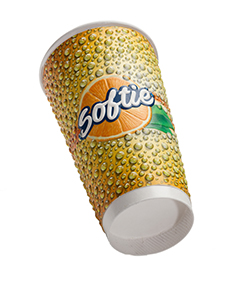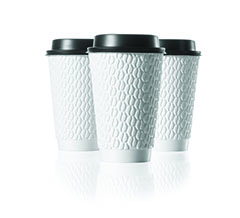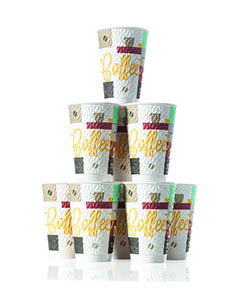Beverage Cups | Taking a Deep Dive into Embossing
- Published: April 18, 2017, By Gary Robinson, BillerudKorsnas
Sustainable paper materials offer unique 3D forming characteristics.
 As any casual coffee drinker can attest, the cup of Joe available at your local gas station has undergone a transformation in the past few years. You’re likely to find a wide array of rich and savory flavor choices for your morning caffeine fix, or possibly even an espresso bar. But it’s not just the coffee that’s received an upgrade; chances are the beverage cup looks—and feels—different too.
As any casual coffee drinker can attest, the cup of Joe available at your local gas station has undergone a transformation in the past few years. You’re likely to find a wide array of rich and savory flavor choices for your morning caffeine fix, or possibly even an espresso bar. But it’s not just the coffee that’s received an upgrade; chances are the beverage cup looks—and feels—different too.
What was once a ubiquitous—and nonrecyclable—synthetic, cold, plastic foam cup is now being transformed into a warming and soothing vessel, made from natural, renewable materials. This new cup, enriched with deeply embossed reliefs and eye-catching branding, delivers a more intimate, personal, and natural experience to the consumer.
NEW PAPER-BASED MATERIALS ENHANCE CONSUMER ENGAGEMENT

This new beverage cup is an example of the unique 3D forming characteristics that are now possible with sustainable paper materials. They are helping brand owners elevate the consumer experience by adding an enhanced sense of touch. Offering unique formability characteristics, these materials can communicate distinctive visual and tactile effects not only on hot beverage cups, but also on cartons, trays, and even stand-up pouches, while providing the benefits of sustainability from a natural and renewable material.
One of the significant benefits of these materials is the ability for intensely deep embossing—up to ten times deeper in fact than traditional paper and cartonboard products. They are also formed through a cold-forming process that requires no heat or excess energy—a definite plus for sustainability efforts. This gives brand owners the leeway to create distinctive 3D effects that not only stand out on retail shelves, but are pleasing to the touch and deliver functional and economic benefits.
For hot beverage cups, deep embossing capabilities provide not only customized 3D designs and tactile feels, but also create pockets of air that insulate consumers from scalding temperatures. By elevating the contact surface, the consumer encounters a pleasant, warm experience that is a tactile re-enforcement of a brand’s communications message. The 3D effects are customized and in-register with the brand’s graphics. Natural insulation properties also mean there is no need for a secondary sleeve, or for a double cup. This not only saves on materials, it also simplifies production, the supply chain, and minimizes space requirements for small cafés and restaurants. In addition to providing a value-added consumer experience, this improves operational efficiencies.
Rich tactile characteristics communicate a “premium” experience each time a product is used. It turns ordinary cartons, trays, and cups, along with other packaging formats, into innovative designs that give brands a lift. Brand owners can conceive new customized packaging that communicates individuality and that gives nondistinctive packaging a new lease on life with embossed reliefs.
DESIGN VERSATILITY
 The 3D forming properties of these materials make them highly versatile. They are FSC-certified, FDA approved for direct food contact, and are ovenable. They can be used alone or as part of a laminate construction for novel food packaging applications.
The 3D forming properties of these materials make them highly versatile. They are FSC-certified, FDA approved for direct food contact, and are ovenable. They can be used alone or as part of a laminate construction for novel food packaging applications.
These materials are used as a base that is laminated into a carton stock board that is designed to work in traditional folding carton operations and deliver super-deep 3D effects. While primarily used for visual and tactile branding enhancements, many leading design teams are now exploring functional benefits associated with this unique forming characteristic. For example, using natural, 3D cold formable paper could replace plastic using existing converting equipment.
These materials can be pre-printed, laminated, and processed through existing high speed thermoforming lines. This is a novel development for natural and renewable materials to operate in a machine built to run plastics. Such cold forming innovations call into question whether the term "thermoforming" is still relevant. By removing “thermo” out of forming, these materials can deliver up to an 80% energy reduction by using less heat and faster cycle times. As a natural, renewable paper, operators would no longer need to melt and then chill the materials as they would a plastic.
Next Up: the Stand-Up Pouch
The stand-up pouch has been a sweeping global trend as brands and consumers move away from rigid packaging to flexible solutions. On the front end, this innovative trend of the stand-up-pouch has delivered converting and transportation efficiencies for brands, as well as a tremendous amount of material reduction.
But, what about end of life? Multilayer plastic pouches have struggled to find an eco-friendly solution after the consumer uses the product. Generally speaking, most of the pouches on the market today cannot be recycled or composted, and they are made almost entirely from non-renewable, oil based plastics. Further, the end-of-life disposal of these flexible laminates are contributing to a growing global challenge of plastic waste in our oceans. Using natural, renewable 3D cold formed paper materials for stand-up-pouches may offer a sustainable solution.
This proprietary pouch can be manufactured on existing converting lines with change parts. As a laminate structure, the pouch can be developed based on specifications from brands and converters—compostable, high-barrier, more flexible, or more rigid. This possibility opens up a world of options for brands looking to make the 3D world of tactile effects for the consumer available in a flexible packaging format.
Sustainable Innovation Begins with Material Selection
Consumers today are seeking more natural products and are grasping for authenticity, seeking real relationships, and drawing the line at what goes on and in their body. They are seeking products with simplified ingredients and contents that are natural and real. Brand owners hear this message every day from their consumers and are seeking value-added innovation to deliver products consumers want. Good, sustainable innovation starts with good materials. By using novel and sustainable materials, brands and converters can do things that have never been done before.
Gary Robinson is director of business development, formable papers, at BillerudKorsnäs. The Sweden-based company produces BillerudKorsnäs FibreForm, which offers new opportunities for all kinds of packaging solutions.











